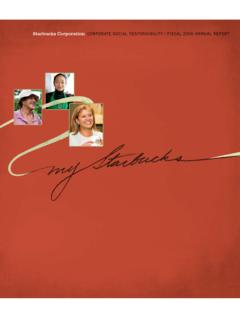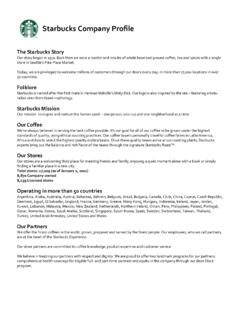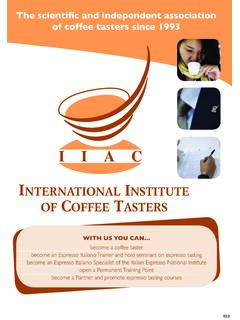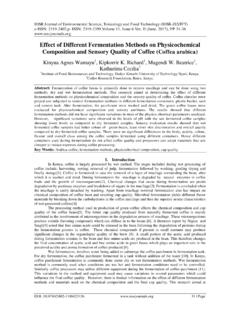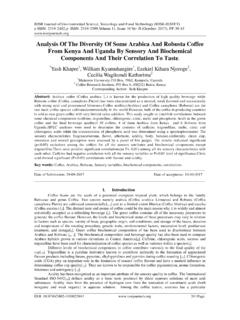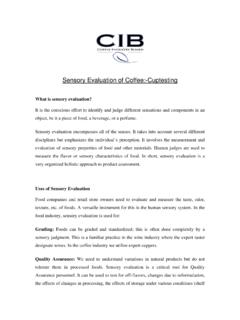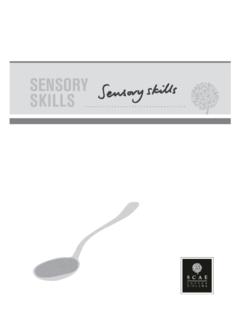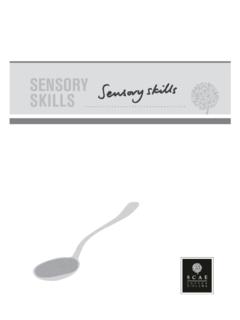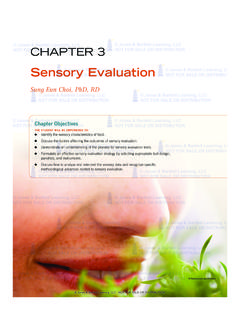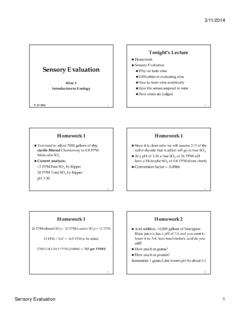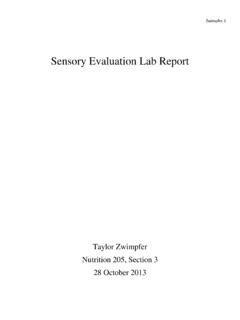Transcription of globalassets.starbucks.com
1 coffee tasting guideThis is my coffee TasTing guidefirsT coffee TasTedhisToriCal daTaDiD you finD this? i neeD it back! Please reTurn Toby email:daTe This guide was sTarTed://favoriTe coffee on This daTe:loCaTion:PrinTed in The usaby faCebook:reward:@ coffee tasting guideIt begins the first time you smell the enticing aroma and sip the coffee . Your coffee Tasting Guide gives you a place to record your sensory journey. It also provides you with what you need to know and communicate about how we ethically source, roast, brew and taste coffee . And to have an even more meaningful connection with our customers and each other over herehow to use Your coffee TasTing guide:Taste each down your thoughts on the pages the sticker from the back of the guide and place on the coffee s coffee InformatIonCoffee IndustryCoffee Buying GrowingProcessingroastingBrewing tastingour coffee LineupStarbucks VIa ready Brew020 taStInG : StarBuCkS BLonde roaSt030 taStInG : medIum roaSt046 taStInG : dark roaSt062 taStInG : SeaSonaL faVorIteS078 taStInG : StarBuCkS reSerVe 096 taStInG : other108 GLoSSaryWelcome to the coffee Tasting Guide, a place to learn about the ways we buy, roast, brew and taste the coffees in our lineup and a place to record your own thoughts as you experience each coffee .
2 Welcome to a new way of organizing our coffees by roast: Starbucks Blonde, Medium and Dark; this makes it easier for our customers to identify the taste they prefer. And welcome to the continuation of our relentless pursuit of leadership in the world of coffee is one of the most important, exciting and rewarding things we taste each coffee . Share your stories. Connect with each other, and with our customers. Listen, expand your knowledge and make all, continue to taste. I hope you enjoy it as much as I Hay SEnIor vICE PrESIDEnT GLoBAL coffee AuTHorITYW elcomecoffee tasting guide5 coffee farming touches the lives of more than 25 million people. It is grown in about 60 countries, primarily on small farms. There are two main species of coffee : arabica and robusta. Starbucks purchases only high-quality arabica coffee grown at high altitudes. Arabica represents about 60 percent of the world s coffee production.
3 We do not buy robusta coffee , which grows at lower elevations and has less refined flavor thing that truly sets Starbucks apart from other coffee companies is our coffee team. The team starts the process by traveling to growing regions and building the relationships that allow us to buy high-quality coffee . They do extensive quality checks throughout the process. And they roast, taste and evaluate every sample received adding up to more than 250,000 cups every year. 900 1,800 metershigh elevationcoffee industrY016learn more: coffee and tea resource manualWe ve always believed that businesses can and should make a positive impact on the communities they serve. So we set goals in the areas of our business where we can have the greatest impact:our Ethical Sourcing commitment to offering the highest-quality, ethically purchased and responsibly produced coffee , tea, cocoa and manufactured goods helps to create a better future for farmers and suppliers.
4 Ethical sourcingenvironmental stewardshipstewardship and communitY involvementcoffee buYing02coffee tasting guide7To measure our impact, we set a goal that by 2015 100 percent of our coffee will be ethically sourced. That means every bean we buy will be third-party verified or certified either through coffee and farmer Equity ( ) Practices, fair Trade or another third-party to knowWe are one of the world s largest purchasers of fair Trade Certified coffee . But the cornerstone of our ethical sourcing is Practices the comprehensive coffee -buying guidelines we ve developed with Conservation International over the last 10 years. There are two prerequisites: product quality and economic accountability, and two scored criteria in social responsibility and environmental leadership. Practices gives purchasing preference to coffee suppliers who grow, process and trade coffee in an environmentally, socially and economically responsible way.
5 The program is built on a model of continuous improvement, and Starbucks encourages coffee cooperatives, farms and supply networks of all sizes and scale to america8learn more: coffee and tea resource manual01. Mexico 02. Guatemala 03. El Salvador 04. Honduras05. Nicaragua06. Costa Rica07. Panama08. Peru09. Colombia10. Puerto Rico11. BrazilThere are three primary coffee -growing regions, each with a distinct landscape, climate and flavor profile for the coffees that are grown and processed there. Crisp acidity with flavors of nuts, cocoa and soft coffee grows near the equator, between the Tropic of Cancer and the Tropic of Capricorn The coffee Belt and coffee s origin country greatly affects its coffee beltgrowing030103060810110204050709afric aasia / pacificcoffee tasting guide912. Rwanda13. Burundi14. Zambia15. Uganda16. Tanzania19. Thailand20. Sumatra21. China22. Indonesia23.
6 JavaLush and juicy, with flavors of floral and citrus to berry and and syrupy smooth with herbal, earthy Kenya18. Ethiopia24. Sulawesi25. Philippines26. East Timor27. Papua New GuineaStarbucks travels the world to discover and purchase the very best beans each region has to offer with the significant flavor characteristics of their more: coffee and tea resource manualProcessing is the term used to describe how the beans (seeds) are removed from the coffee cherry. Processing plays a part in overall flavor, acidity and pulp is mechanically removed, leaving a sticky layer called mucilage on the bean. Beans are washed and then held in a concrete fermentation tank for 18 36 hours to develop flavor, acidity and body. one final washing, and the beans are dried, parchment is removed and the green beans are sorted and pulp is removed using small hand-pulping machines, and then the coffee is washed and laid out to dry in the sun.
7 After partial drying, parchment is removed and the coffee is laid out again for final drying, followed by sorting and grading. coffee cherries are allowed to dry completely on the bean, letting the bean develop flavors before the skin and parchment are removed, followed by sorting and processingsemi-washed processingnatural processinglight, clean and tangylower acidity, light-bodied and smoothwild, unpredictable and berryprocessing04coffee tasting guide11 The Starbucks roast is not a time, temperature or color it s a philosophy. We organize our coffees in three roast profiles, Starbucks Blonde roast, Medium and Dark roast. research tells us that customers use roast to indicate flavor, so these profiles help them quickly find coffees they ll coffees have a shorter roast time, lighter body and mellow flavors. Medium-roasted coffees are balanced with smooth and rich coffees feature a fuller body and robust, bold coffee requires a unique roast profile to create a cup that is at its peak of aroma, acidity, body and to knowBmDroasting0512learn more: coffee and tea resource manualproportion Starbucks recommends 2 Tbsp (10 g) ground coffee for every 6 fl oz (180 ml) of water for proper Grind determines how long the water and coffee are in contact, and how much flavor is extracted.
8 Proper grind delivers only the coffee s best coffee is 98 percent water, so fresh, good-tasting water is essential. If your local tap water tastes good, it s likely to make a good cup of coffee . otherwise use filtered or bottled Think of coffee as fresh produce. The enemies of coffee are oxygen, light, heat and moisture. Store opened coffee in an opaque, airtight container (like a flavorLock bag) at room temperature, and use within a week of you grind, brew and store coffee is as important as the coffee you of brewing great coffeeESPRESSodRIPPRESS coffee tasting guide13 Start with coarsely ground coffee (2 Tbsp for every 6 fl oz water). To brew great coffee , follow the four fundamentals: Proportion, Grind, Water and Freshness. how to brew in a coffee press(By far our preferred brewing method.)[01.] [02.] [03.] [04.] Add hot water just off the for four press and more: coffee and tea resource manualtasting07 Whenever you taste coffees, compare and contrast them by identifying the four tasting characteristics for each: aroma, acidity, body and The way the coffee smells it could be earthy, spicy, floral, nutty or others.
9 These distinctive aromas are directly related to the coffee s flavor. aciditY This is a tangy quality or tartness, not the pH level of the coffee . You can feel acidity on the sides and tip of your tongue, and sometimes the back of your jawbone, the way you do when you taste citrus fruits or drinks. Coffees with high acidity are described as bright, tangy and crisp with a clean finish. Low-acidity coffees feel smooth in your mouth and The weight of the coffee on your tongue. Does it feel light or full in your mouth? Like comparing whole milk with nonfat milk. Light-bodied coffees feel light and don t linger; you feel the weight of full-bodied coffees on your tongue and the flavor The way the coffee tastes. This characteristic is registered in different parts of the mouth. Citrus, cocoa and berries are a just a few flavors you might taste. Some are obvious, and others are tasting guide15follow each of these steps every time you taste to truly appreciate the characteristics of the coffees.
10 See how the characteristics you like correspond to region, processing method and four steps of coffee tastingEach coffee in our lineup is unique taste and compare their aroma, acidity, body and flavor.[01.] smell Always smell a coffee before you taste it. Your tongue distinguishes only four tastes: salty, sweet, bitter and sour but your nose can detect thousands of smells. Cup your hand over the coffee , hold the cup close to your nose and inhale.[02.] slurp When tasting a coffee , it s important to slurp it. Slurping sprays the coffee across your entire palate and lets subtle flavors and aromas reach your nose.[03.] locate Think about where you are experiencing flavors on your tongue. Is it on the tip and sides? What is the mouthfeel and weight of the coffee on your tongue?[04.] describe now that you ve smelled and tasted the coffee , think about how you would describe the experience.


